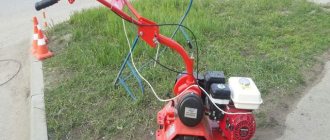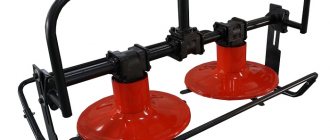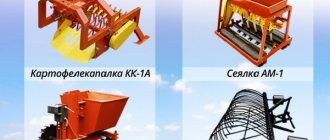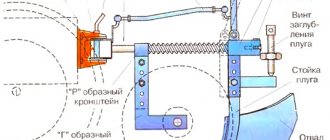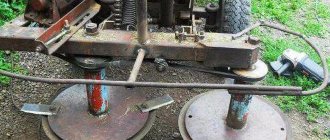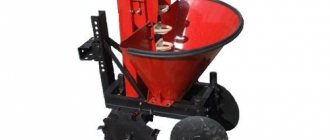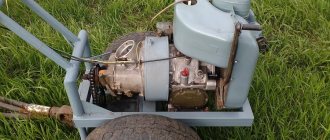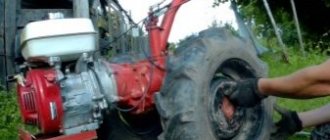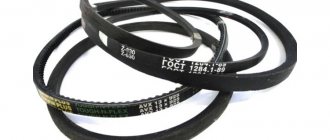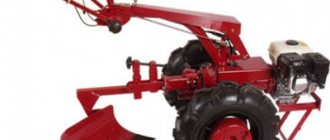"Salyut 100": device description
The Russian one in the Yaroslavl region, where Salyut walk-behind tractors are produced, began producing these units back in 2002. "Salyut 100" is a unit with multi-purpose use. The list of works performed by this miracle technology allows you to use the walk-behind tractor as a snowblower, for harrowing, and much more.
The Salyut 100 walk-behind tractor has a gasoline engine; it is also expected to be available with a diesel engine, which ensures longer operation. This mechanism operates in a driven and trailed state. Thanks to this, the walk-behind tractor trolley can move at speeds of up to 8 km/h.
The Salyut 100 walk-behind tractor is perhaps the best Salyut model for today: it is light in weight and size, easy to operate, the model is highly efficient and reliable in operation, maintenance and transportation of the unit are not difficult.
Did you know? The production of the first walk-behind tractors under the USSR began in the late seventies of the last century. Two pioneers, the Perm Aircraft Engine Plant and the Leningrad Aircraft Engine Plant, began production almost simultaneously.
How to make a homemade potato digger for a walk-behind tractor
It is better to purchase purchased agricultural equipment for large sown areas. For owners of small garden plots, home-made potato digger models are quite suitable. The main points that should be taken into account are the possibility of easy installation on a walk-behind tractor, efficiency and adequacy to the type of soil being treated.
It is also worth familiarizing yourself with the main types of attachments for digging potatoes and deciding which option is more suitable. For example, a passive lancet universal potato digger will do an excellent job with light, loose soil. It is easy to make from an old used shovel, and reinforcement rods are suitable for rods. This will not require complex measurements, drawings, or technical calculations.
More complex vibrating or conveyor belt applications will require more extensive preparation.
Technical characteristics of Salyut 100: model features
The characteristics of the walk-behind tractor are impressive:
- Engine of the Salyut walk-behind tractor: Lifan 168F-2B, OHV; horizontal shaft; 196 cm3.
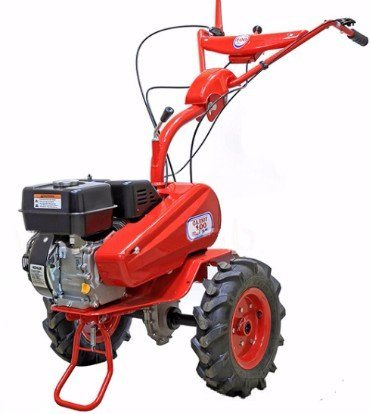
Transmission: belt clutch; gear reducer; 4 forward gears, 2 reverse, it is possible to rearrange the drive pulley; power take-off using a pulley.- Average speed: 2.8–7.8 km/h.
- Power of the Salyut walk-behind tractor (max.): 4.8 kW (6.5 hp) at 3600 rpm.
- Fuel tank volume: 3.6 l.
- Crankcase oil capacity: 0.6 l.
- Transport gauge: 360/650 mm.
- Milling cutter diameter: 320 mm.
- Processing width (during cultivation): 300/ 600/ 980 mm; depth – up to 250 mm
Making and assembling a potato digger
On the Internet you can find ready-made or create your own drawings for assembling the device. The main parts are as follows: a base (frame) for fastening parts, a plow for digging up soil, a linkage system, adjustable traction, soil hooks or other suitable wheels. By the way, lugs can also be made by hand. The process of assembling a potato digger begins with the manufacture of parts, and it takes place in several stages:
- Frame welding. It is made from channel No. 8 and a metal corner, the total length of the base should be approximately 1 m 20 cm.
- Then two more channels are welded: the first - one third from the beginning of the frame, the second - at a distance of about one sixth from the edge, which will be located in front. The adjustment rod of the mechanism will be installed on them.
- Metal posts are welded on the sides, on both sides, the distance between them should be about 10 cm - they will serve as fasteners for the future grille.
- The remaining channel should be attached to the outer posts; you should get two triangles, onto which the plow will subsequently be attached.
- Next, a strip of the required length, about 3 cm wide, is cut out of the metal sheet, and it is first welded to one of the triangles. After complete cooling, the strip is bent with a sledgehammer and welded to the second triangle.
- The plowshare can be made from a metal plate, a piece of pipe, or an old plow. It is attached to the elevator casing using 4 bolts, the nuts are firmly tightened.
- The reinforcement is divided into rods of the required length. One side of them is welded to a metal plate, the distance between them should be about 5 cm. Additional rods or plates can be attached to the sides so that the tubers do not fall in different directions. The second part of the rods is attached to a plate or pipe, which should be attached with hinges for free movement.
- Then the reduction unit is installed. It will allow you to change the angle of inclination of the elevator and plow as needed.
- The wheels are attached to the connecting bridge of the equipment.
- Attaching the potato digger to the walk-behind tractor is similar to the fastenings of other attachments.
Whatever model the gardener chooses, one thing is certain – modern technology can significantly facilitate the farmer’s work and save a lot of time.
Full set of walk-behind tractor "Salyut 100"
The complete set of equipment for the walk-behind tractor includes: six pieces of separate tillers for the soil, disks that protect vegetation; mobile milling shields; two wheels and bushings for the axles; vomer; bracket for hanging components; oil dipstick; tools.
The following equipment can be connected to this modification of the walk-behind tractor: rotary and finger mowers, a device for throwing snow, a broom-brush, a shovel.
The Salyut motor-cultivator is equipped with specially shaped cutter-knives; for easier entry into the ground, the knives are sickle-shaped and made of reliable spring steel. The kit includes three pairs of bolted cutters that connect the steel pins.
Important! To transmit torque to towed equipment, the belt is installed on the driven clutch pulley.
Potato digger KKM-1 (vibrating)
Specifications
Potato digger KKM-1 (vibro) for walk-behind tractor - designed for mechanized digging of potato tubers from the ground, laying them on the surface for further manual picking. In addition, the mechanism can be used to collect onions, beets, and garlic.
The KKM-1 module consists of an active share (knife) and a screening grid (screen). It is possible to regulate the digging depth using support wheels, and the softness of soil separation is regulated using the engine speed of the walk-behind tractor.
The KKM-1 potato digger is aggregated with walk-behind tractors of the following types: "NEVA", "Salyut", "Cascade", "Favorit", "MTZ" and walk-behind tractors of a similar design. The potato digger is designed to work on light and medium soils with a humidity of no more than 27%, clogged with stones up to 8-9 t/ha, with soil hardness up to 20 kg/cm2. The size of the support wheel tires is 330×90mm. Drive from the engine pulley is a V-belt A - 1180.
What can a walk-behind tractor do in your garden?
A wide variety of work can be done with the Salyut walk-behind tractor:
- the unit effortlessly cultivates the soil, plows, forms furrows, loosens and harrows the soil;
- The walk-behind tractor cuts the grass on the lawns and cleans the garden paths;
- with it you can hill up plantings and dig up tubers and root crops;
- the walk-behind tractor is capable of pumping water and transporting any cargo;
- For winter, a snow blower is provided for the Salyut walk-behind tractor.
The walk-behind tractor is suitable for work in the garden, garden, greenhouse and even in mountainous areas.
The forged cutters of the walk-behind tractor allow you to work on all types of soil, including virgin soil. A convenient steering wheel, adjustable in height and sides, makes it possible not to follow the unit across the arable land. “Salute” is also adjustable to the desired width and depth when cultivating the land. In addition to all of the above, the walk-behind tractor can be used as a power source. Interesting! The production of walk-behind tractors in the USSR was limited not only to Russia. In Armenia (Yerevan) they produced tires for units; in Georgian Kutaisi, under an Italian license, they produced assembled walk-behind tractors; in Ukraine, the only plant that has mastered the production of walk-behind tractors and which is still operating today is in the city of Khmelnitsky.
Attachments
The capabilities of agricultural machinery are determined by the ability of the attachment to easily adapt to the Salyut walk-behind tractor and effectively carry out essential agricultural work for summer residents and gardeners. It’s clear that the more diverse the list of auxiliary devices, the greater the number of them that can be mechanized, thereby using the equipment as efficiently as possible.
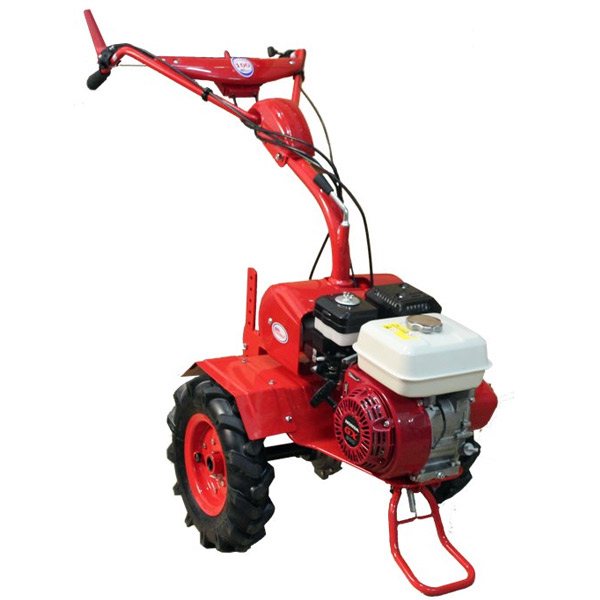
“Salyut-100” and the earlier modification “Salyut-5” are rationally aggregated with more than 50 types of modern attachments, adapted to perform many useful jobs.
The kit with the Salute walk-behind tractor includes a minimum list of accessories.
To perform specialized work, appropriate attachments have been created, which are purchased separately. Let's take a closer look at the different types of these devices.
Adapter
The adapter is a specific towed device for a walk-behind tractor. The operator can perform various tasks while sitting on a comfortable seat and easily controlling the walk-behind tractor. Having an adapter, many functions can be performed much more efficiently and safely, especially when cultivating the soil with cutters.
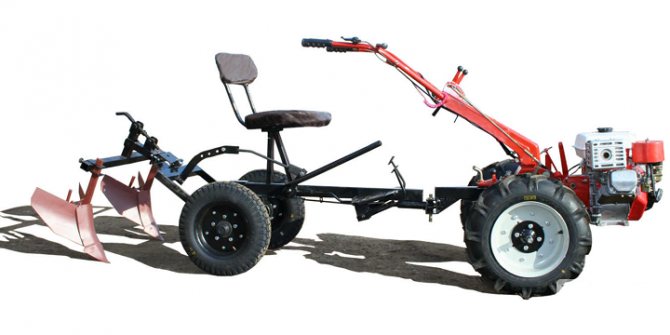
Depending on the purpose, there are various designs of adapters for the Salute walk-behind tractor:
- simple - intended purely for cultivating the land;
- universal - designed for transportation of goods, various types of soil treatment.
Adapters with a long drawbar are installed on heavy, powerful machines; for light modifications, adapters with a short drawbar are installed. Modifications of adapters with additional functionality have been developed - lifting the overall linkage, widening the track.
Mower
One of the most difficult types of rural work is mowing. With a mounted mower on a Salyut walk-behind tractor, today this is quite an ordinary job.

Mowers for the Salute walk-behind tractor are:
- segmental - for mowing evenly growing thin grass on flat surfaces;
- disc (rotary) - better suited for mowing grasses of different qualities. Taking into account the density, hardness, lodging of the grass layer, and the quality of dead wood, you can optimally configure the rotary mower in accordance with the speed of the machine and engine rotation.
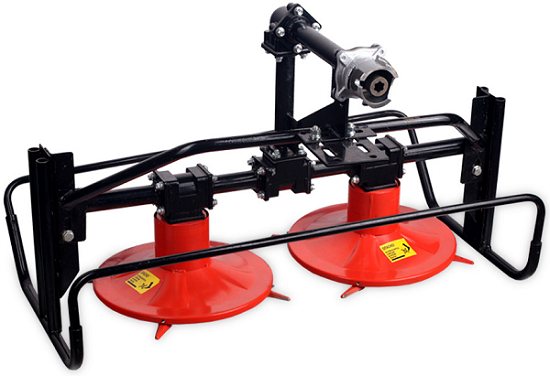
The Zarya disc mower works well with the Salyut walk-behind tractor, the capabilities of which allow you to mow bushes and tangled, lying grass. The video shows the effective operation of the Zarya mower, which works on the principle of a regular scythe - it mows and lays the grass into even swaths.
Video review of the operation of the Zarya mower on the Salyut walk-behind tractor
Potato digger
Labor-intensive, extremely tedious work - digging potatoes - can be significantly simplified with the help of a mounted potato screener. No damaged tubers, no shovels - a minimum of time, effort and excellent results.
As an attachment for the Salyut walk-behind tractor, a KV-3 potato digger weighing 5 kg is the most popular device.
Potato planter
The potato planter is a not so popular attachment for the Salute walk-behind tractor.
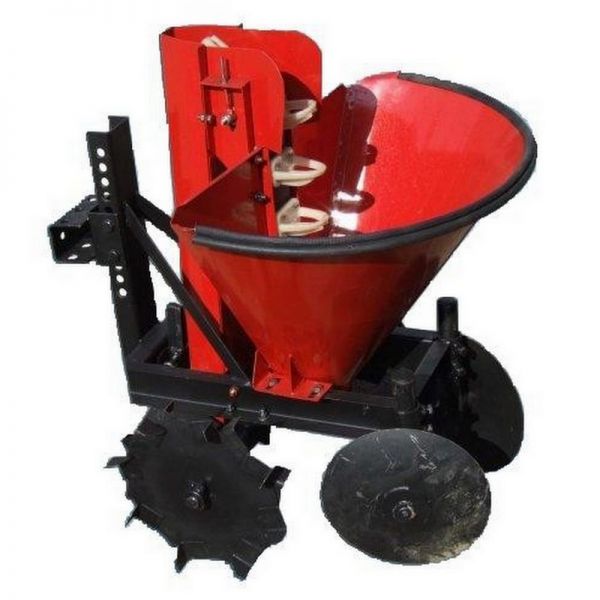
As is usually the case, in small country gardens, potatoes are planted using the extensive method - a friendly raid of all relatives and friends. On large leased plots, the effectiveness of using a potato planter as an attachment is undeniable. You can see the operation of a potato planter on a walk-behind tractor in the video.
Video review of the operation of a potato planter on a Salyut-100 walk-behind tractor
Hillers
Planting and sowing is one thing to worry about, but weeding, hilling and tireless weed control - these chores on the site sometimes take quite a lot of time. Hilling up using a Salyut walk-behind tractor with a universal harrow is easier than plowing the land; you just need to correctly adjust the angle of attack of the equipment.
Depending on the quality of the soil and the work performed, hillers are divided into:
On average, in an eight-hour working day, it is possible to hill up row crops on an area of at least 10-12 hectares.
Using a disc harrow, setting the required distance between the discs, you can conveniently hill up potatoes.
Video review of hilling potatoes on a Salyut-100 walk-behind tractor
Blade shovel
The blade, when combined with the Salyut walk-behind tractor, performs the functions of a wide shovel.
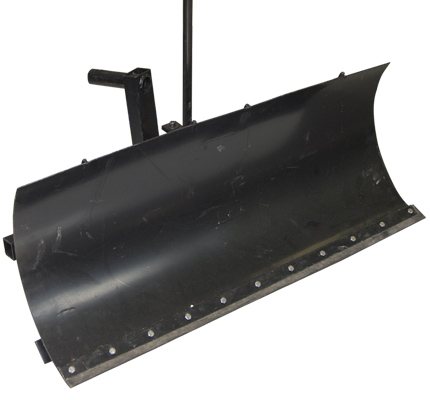
This device is convenient for removing snow, clearing the area of construction or other debris, and, if necessary, leveling sand, soil, and small crushed stone.
Video review of the operation of a shovel blade on a Salyut-100 walk-behind tractor
Trailers
The Salute walk-behind tractor with a mounted trailer is an indispensable thing in the household, a necessary equipment in the garden. Currently, you can buy trailers of various configurations, different load capacities, regular and dump, which are conveniently adapted to different models of walk-behind tractors.
How to use the Salyut 100 walk-behind tractor correctly
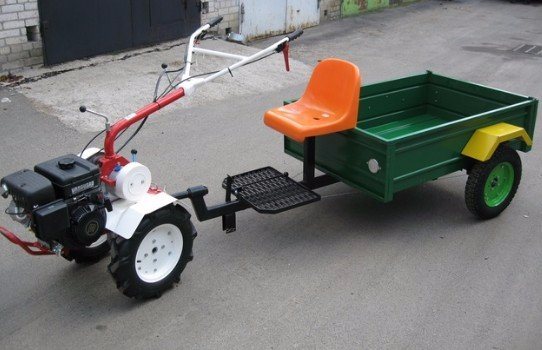
Attention! Without a coulter, the walk-behind tractor will twitch and jump in your hands, often burying itself in the ground. You will have to constantly shift into reverse gear to emerge from the soil.
If you want to plow virgin lands with a Salyut walk-behind tractor, do it in several stages. Stage one - at minimum speed, remove the crust from the top layer, the turf will go away with it. In the second approach, in first gear, at medium speed, go slightly deeper to lift the lumps to the surface. And for the third time, use deep plowing to thoroughly loosen the soil.
When plowing the soil in several approaches, change the direction. At the same time, it is better and easier to work on dry soil. If you went through the first time, lifting the wet layer, then take your time - let it dry. Another piece of advice: always check the oil level, fill the unit with high-quality gasoline, and there will be no problems with the equipment.
Planting potatoes with the Salyut walk-behind tractor
First of all, you need to prepare the soil. In the spring, it is cultivated with a walk-behind tractor; instead of wheels, they use cutters, which are usually included in the kit. The process of cultivating the soil requires a certain skill, but you should not rush, it is important to properly prepare the land. They start from the edge of the plot, then turn the walk-behind tractor, place one cutter in the middle of the first furrow and go through the next row. It turns out that each strip is processed twice. This will take longer, but the depth of cultivation will be sufficient and the soil will be loose and soft. After such processing, only the edges of the area where the equipment was turned are leveled with a rake.
Before planting, you need to prepare the walk-behind tractor and install the appropriate equipment on it. Additionally you will need: axle extensions, hitch, plow, lugs. Sometimes gardeners use a single-row hiller, but experienced gardeners believe that with the help of a plow the process is more convenient and easier. In this case, you do not need to mark with markers and calculate the distance between the rows.
The cutters are removed from the walk-behind tractor and axle extensions are installed, with soil hooks on them (these are special wheels for hilling, their diameter is usually about 40 cm). There are two holes on the extensions, the lugs are attached to the outer ones - then there is a distance of 70 cm between the wheels.
In this video you will learn how to connect a potato digger:
This distance is considered optimal for rows; future hilling with a walk-behind tractor will also be convenient. Next, the depth stop is removed and the hitch and plow are installed. In this form, the equipment is completely ready for work.
The planting scheme is simple: a bed is cut in one direction, and in the opposite direction it is covered with earth. Start from the edge, the first strip should be made smooth and neat, then the rest will be parallel. Some gardeners recommend pulling a cord or rope and walking the first row along it. This advice is suitable for those who are just learning to work with walk-behind tractors. After plowing the first row, prepared potatoes are placed in it, the interval between tubers is about 30 cm.
Next, the device is deployed and placed in such a way that the right ground hook is located to the right of the potato, but does not touch it. They pass along the first furrow, covering it with earth. The result is a neat row with potatoes planted inside. The work with the next rows is identical. With this planting technology, the distance between the beds is 70 cm, the tubers are covered with a thick layer of soil, which will have a beneficial effect on the growth of the plant.
